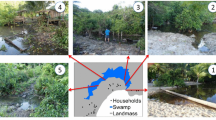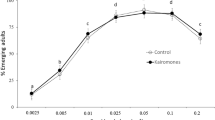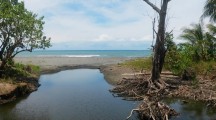Abstract
Anopheles gambiae s.l. is the main vector of malaria in Sub-Saharan Africa. Here, an estimated 1 million people die every year from this disease. Despite considerable research on An. gambiae that increasingly explores sub-organismal phenomena, important facets of the field biology of this deadly insect are yet being discovered. In the current study, we used simple observational tools to reveal that the habitat of larval An. gambiae is not limited within the boundaries of temporary mud puddles, as has been the accepted generalization. Thus, control tactics aimed at immatures must consider zones larger than puddles per se. In fact, eggs are more likely to be found outside than inside puddles. Eggs can develop and larvae can emerge on mud. Larvae are then capable of three distinct modes of terrestrial displacement (two active and one passive), whereby, they can reach standing water. On mud bearing a film of water, larvae actively displace backwards by sinusoidal undulations shown to be only a slight variation of the swimming motor program. On drying mud, larvae switch to a slower and forward form of active locomotion resembling that of a crawling caterpillar. During rains, small larvae may be passively displaced by flowing rainwater so as to be deposited into puddles. These capabilities for being amphibious, along with very rapid growth and development, help explain how An. gambiae thrives in a highly uncertain and often hostile larval environment.

Similar content being viewed by others
References
Bray AM (2003) Ovipositional behavior of Anopheles gambiae as influenced by variable substrates and chemicals. M.S. Thesis, Michigan State University
DeBelle JS, Sokolowski MB, Killiker AJ (1993) Genetic analysis of the foraging microregion of Drosophila melanogaster. Genome 36:94–101
Hinton HE (1969) Respiratory systems of insect egg shells. Annu Rev Entomol 14:343–368
Huang J, Walker ED, Giroux PY, Vulule J, Miller JR (2005) Ovipositional site selection by Anopheles gambiae: influences of substrate moisture and texture. J Med Entomol 19:442–450
Huang J, Miller JR, Chen S, Vulule JM, Walker ED (2006) Anopheles gambiae (Diptera:Culicidae) oviposition in response to agarose media and cultured bacterial volatiles. J Med Entomol 43:498–504
Koenraadt CJM, Paaijmans KP, Githeko AK, Knols BGJ, Takken W (2003) Egg hatching, larval movement and larval survival of the malaria vector Anopheles gambiae in desiccating environments. Malar J 2:20–28
McCrae AWR (1984) Oviposition by African malaria vector mosquitoes. II. Effect of site tone, water type and conspecific immature on target selection by fresh water Anopheles gambiae Giles, sensu lato. Ann Trop Med Parasitol 78:307–318
Mutuku FM, Alaii J, Bayoh MN, Vulule JM, Kamau L, Walker ED, Hawley WA (2006) Pupal habitat productivity of Anopheles gambiae complex mosquitoes in a rural village in western Kenya. Am J Trop Med Hyg 74:54–61
Nikolsky VV (1924) Observations on the ability of larvae of An. maculipennis Mg to crawl. Russ Trop Med 2:44
Rosenberg R (1982) Forest malaria in Bangladesh III: breeding habitats of Anopheles dirus. Am J Trop Med Hyg 31:192–201
Shililu JI, Grueber WB, Mbogo CM, Githure JI, Riddiford LM, Beirer JC (2004) Development and survival of Anopheles gambiae eggs in drying soil: influence of the rate of drying, egg age, and soil type. J Am Mosq Control Assoc 20:243–247
WHO (2000) World Health Organization Expert Committee on Malaria, Twentieth Report. Geneva, Switzerland
Acknowledgements
We thank Samson Otieno, Said Juma (recently deceased), Ben Oloo, and Alfred Odhiambo of the Kenya Medical Research Institute for assistance in collecting mosquitoes and quantifying rates of displacement of larvae on mud. Mark Geralds of the Instructional Media Center at MSU edited the accompanying video. This research was supported by NIH Grant AI50703.
Author information
Authors and Affiliations
Corresponding author
Electronic Supplementary Material
Below is the link to the electronic supplementary material.
S1 is a 3.5-min close-up video showing: rapid emergence of malaria mosquito larvae from eggs receiving a drop of water, swimming behavior, and tail-lashing and caterpillaring on semi-solid agarose substrate (1.57 MB).
Rights and permissions
About this article
Cite this article
Miller, J.R., Huang, J., Vulule, J. et al. Life on the edge: African malaria mosquito (Anopheles gambiae s. l.) larvae are amphibious. Naturwissenschaften 94, 195–199 (2007). https://doi.org/10.1007/s00114-006-0178-y
Received:
Revised:
Accepted:
Published:
Issue Date:
DOI: https://doi.org/10.1007/s00114-006-0178-y




